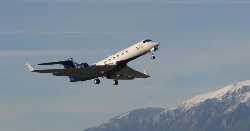AIRCREW SAFETY & HEALTH

Photo courtesy of Julie Haggerty (NCAR)
Musculoskeletal Disorders
What you need to know
Aircrew may be at risk for musculoskeletal disorders. Work-related strains and sprains of muscles, tendons, and supporting tissues can happen from lifting, bending, carrying, reaching, working in confined spaces, and using repetitive motions. Turbulence or sudden airplane movements can cause imbalance, increasing risk of injury associated with a fall. Here you can learn more about what you can do to reduce your risk of developing these kinds of job-related injuries.
What are musculoskeletal disorders?
Musculoskeletal disorders are short or long-term injuries to the nerves, tendons, muscles and the supporting structures of the body, such as bones and ligaments.
A musculoskeletal disorder is considered work-related if the injury is caused or aggravated by work tasks such as:
- lifting,
- pushing,
- pulling,
- reaching,
- prolonged standing,
- awkward postures including twisting,
- constrained postures,
- performing repetitive motions
Symptoms of musculoskeletal disorders can include:
- pain
- stiffness
- swelling
- numbness
- tingling
What you can do to reduce or eliminate exposure
When possible, avoid or limit:
- Awkward body postures (bent or twisted back, arms overhead or far in front of the body)
- Repetitive movements
- Heavy or overhead lifting
- Forceful pushing or pulling
- Ask your employer to fix a cart if the wheels do not operate properly
If you are pregnant:
- Reduce heavy/bulky lifting in accordance with the NIOSH provisional guidelines.
- Reduce or eliminate
- Stooping, bending, or twisting at the waist
- Lifting overhead
- Lifting from below mid-shin
For more information
- NIOSH Topic Page: Ergonomics and Musculoskeletal Disorders
- NIOSH Upper Limb Research Consortium
- NIOSH Back Belt Studies Summary
- Infographic: Recommended Weight Limits for Lifting at Work during Pregnancy
- NIOSH publication: Clinical guidelines for occupational lifting during pregnancy (2013)
- NIOSH publication: Provisional recommended weight limits for manual lifting during pregnancy (2014)
- Psychosocial risk factors for work-related musculoskeletal disorders of the lower-back among long-haul international female flight attendants (2008)
- If you have safety and health questions about your job contact us
- Page last reviewed: May 9, 2017
- Page last updated: May 9, 2017
- Content source:
- National Institute for Occupational Safety and Health Division of Surveillance, Hazard Evaluations and Field Studies


 ShareCompartir
ShareCompartir